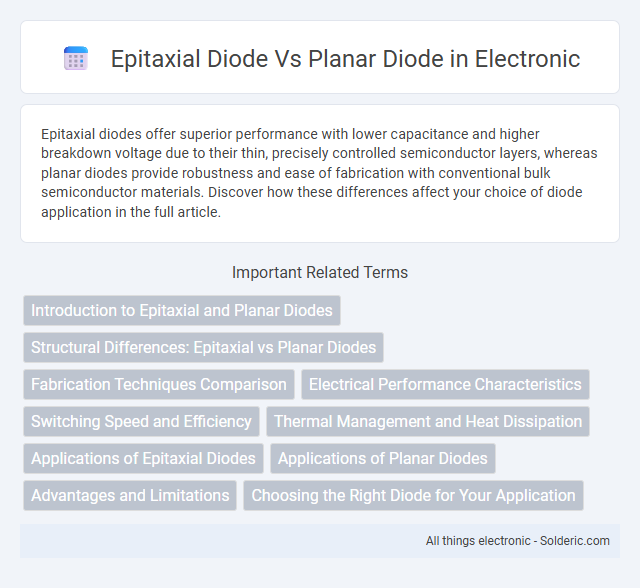Epitaxial diodes offer superior performance with lower capacitance and higher breakdown voltage due to their thin, precisely controlled semiconductor layers, whereas planar diodes provide robustness and ease of fabrication with conventional bulk semiconductor materials. Discover how these differences affect your choice of diode application in the full article.
Comparison Table
| Feature | Epitaxial Diode | Planar Diode |
|---|---|---|
| Manufacturing Process | Layer grown epitaxially on substrate | Diffused or implanted on wafer surface |
| Junction Quality | High purity, uniform junction | Good but less uniform than epitaxial |
| Breakdown Voltage | Higher breakdown voltage capability | Lower breakdown voltage limit |
| Leakage Current | Lower leakage current | Higher leakage current |
| Switching Speed | Faster switching due to controlled doping | Slower switching |
| Application | High-frequency and power applications | General purpose low power circuits |
| Cost | Higher manufacturing cost | Lower manufacturing cost |
Introduction to Epitaxial and Planar Diodes
Epitaxial diodes are fabricated using a layer-by-layer growth process on a semiconductor wafer, resulting in superior control over electrical characteristics such as doping concentration and junction depth. Planar diodes, on the other hand, rely on diffusion techniques to form junctions on the wafer surface, making them simpler but often less precise in performance. Your choice between epitaxial and planar diodes depends on the required device efficiency, switching speed, and application-specific parameters.
Structural Differences: Epitaxial vs Planar Diodes
Epitaxial diodes feature a thin, highly controlled semiconductor layer grown on a substrate, resulting in superior uniformity and performance. Planar diodes utilize a diffused junction formed on the wafer surface, offering simpler manufacturing but less control over junction depth and doping levels. Your choice between epitaxial and planar diodes impacts device reliability, switching speed, and breakdown voltage characteristics.
Fabrication Techniques Comparison
Epitaxial diodes are fabricated using epitaxial growth, where a single crystal semiconductor layer is deposited on a substrate, enabling precise control over doping concentration and thickness, which improves device performance and breakdown voltage. Planar diodes are manufactured through diffusion or ion implantation on the semiconductor wafer surface, offering simpler processing but less control over junction depth and uniformity compared to epitaxial methods. The epitaxial technique yields higher-quality junctions with enhanced electrical characteristics, while planar fabrication is cost-effective and widely used for standard applications.
Electrical Performance Characteristics
Epitaxial diodes exhibit lower leakage currents and higher breakdown voltages compared to planar diodes due to their precisely controlled doping profiles and reduced surface defects. The epitaxial layer enhances carrier mobility and reduces junction capacitance, resulting in improved switching speeds and efficient signal processing. Planar diodes, while simpler to manufacture, generally demonstrate higher junction capacitance and increased parasitic effects, limiting their performance in high-frequency and high-voltage applications.
Switching Speed and Efficiency
Epitaxial diodes exhibit faster switching speeds compared to planar diodes due to their thinner epitaxial layers, which reduce charge storage and carrier transit time. This structural advantage enhances their efficiency in high-frequency applications, making them ideal for RF and switching power supplies. Planar diodes, while robust and cost-effective, generally have slower switching speeds and lower efficiency because of their thicker junctions and longer charge carrier lifetimes.
Thermal Management and Heat Dissipation
Epitaxial diodes exhibit superior thermal management due to their layered semiconductor structure, which allows for more efficient heat dissipation compared to planar diodes. The epitaxial layer enhances electron mobility and reduces junction resistance, minimizing heat generation during operation. Planar diodes typically have higher thermal resistance, leading to increased junction temperatures and reduced reliability under high power conditions.
Applications of Epitaxial Diodes
Epitaxial diodes are widely used in high-frequency and high-power applications due to their superior electron mobility and reduced capacitance compared to planar diodes. These diodes are essential in RF circuits, microwave communication systems, and power rectifiers where fast switching and high efficiency are critical. Your choice of epitaxial diodes enables improved performance in advanced electronics requiring precise control of current flow and minimal signal loss.
Applications of Planar Diodes
Planar diodes find extensive applications in high-frequency and high-power circuits due to their excellent surface passivation and low leakage currents. They are ideal for use in RF detectors, voltage clamps, and signal mixers, benefiting from their rugged structure and reliable performance. The planar process allows for precise control of diode characteristics, making these diodes suitable for integrated circuit fabrication and high-volume manufacturing.
Advantages and Limitations
Epitaxial diodes offer superior control over doping profiles and thickness, resulting in lower series resistance and higher breakdown voltage compared to planar diodes. They excel in high-frequency and high-power applications due to their improved performance characteristics but are more expensive and complex to manufacture. Your choice depends on whether you prioritize enhanced electrical properties or cost-efficiency and simpler fabrication.
Choosing the Right Diode for Your Application
Epitaxial diodes offer superior performance in high-frequency and high-voltage applications due to their controlled doping profiles and reduced leakage currents, making them ideal for RF circuits and power rectification. Planar diodes, with their simpler manufacturing process and cost-effectiveness, are suitable for low to moderate voltage applications where ruggedness and ease of integration are priorities. Selecting the right diode depends on factors such as voltage requirements, switching speed, thermal stability, and cost constraints specific to the intended electronic circuit.
Epitaxial diode vs Planar diode Infographic

 solderic.com
solderic.com